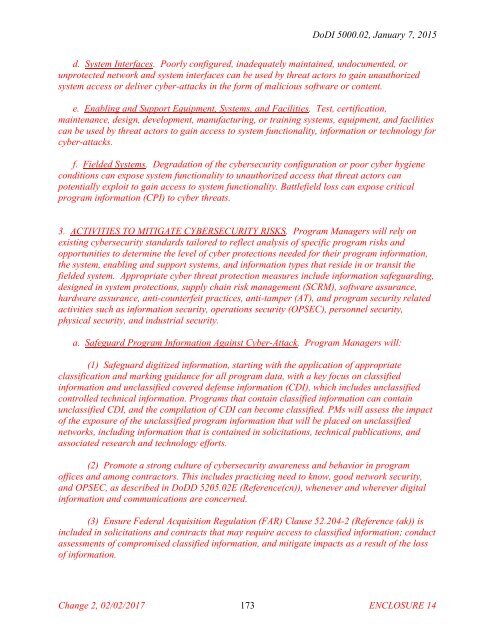Department of Defense INSTRUCTION
x9tnk
x9tnk
Create successful ePaper yourself
Turn your PDF publications into a flip-book with our unique Google optimized e-Paper software.
DoDI 5000.02, January 7, 2015<br />
d. System Interfaces. Poorly configured, inadequately maintained, undocumented, or<br />
unprotected network and system interfaces can be used by threat actors to gain unauthorized<br />
system access or deliver cyber-attacks in the form <strong>of</strong> malicious s<strong>of</strong>tware or content.<br />
e. Enabling and Support Equipment, Systems, and Facilities. Test, certification,<br />
maintenance, design, development, manufacturing, or training systems, equipment, and facilities<br />
can be used by threat actors to gain access to system functionality, information or technology for<br />
cyber-attacks.<br />
f. Fielded Systems. Degradation <strong>of</strong> the cybersecurity configuration or poor cyber hygiene<br />
conditions can expose system functionality to unauthorized access that threat actors can<br />
potentially exploit to gain access to system functionality. Battlefield loss can expose critical<br />
program information (CPI) to cyber threats.<br />
3. ACTIVITIES TO MITIGATE CYBERSECURITY RISKS. Program Managers will rely on<br />
existing cybersecurity standards tailored to reflect analysis <strong>of</strong> specific program risks and<br />
opportunities to determine the level <strong>of</strong> cyber protections needed for their program information,<br />
the system, enabling and support systems, and information types that reside in or transit the<br />
fielded system. Appropriate cyber threat protection measures include information safeguarding,<br />
designed in system protections, supply chain risk management (SCRM), s<strong>of</strong>tware assurance,<br />
hardware assurance, anti-counterfeit practices, anti-tamper (AT), and program security related<br />
activities such as information security, operations security (OPSEC), personnel security,<br />
physical security, and industrial security.<br />
a. Safeguard Program Information Against Cyber-Attack. Program Managers will:<br />
(1) Safeguard digitized information, starting with the application <strong>of</strong> appropriate<br />
classification and marking guidance for all program data, with a key focus on classified<br />
information and unclassified covered defense information (CDI), which includes unclassified<br />
controlled technical information. Programs that contain classified information can contain<br />
unclassified CDI, and the compilation <strong>of</strong> CDI can become classified. PMs will assess the impact<br />
<strong>of</strong> the exposure <strong>of</strong> the unclassified program information that will be placed on unclassified<br />
networks, including information that is contained in solicitations, technical publications, and<br />
associated research and technology efforts.<br />
(2) Promote a strong culture <strong>of</strong> cybersecurity awareness and behavior in program<br />
<strong>of</strong>fices and among contractors. This includes practicing need to know, good network security,<br />
and OPSEC, as described in DoDD 5205.02E (Reference(cn)), whenever and wherever digital<br />
information and communications are concerned.<br />
(3) Ensure Federal Acquisition Regulation (FAR) Clause 52.204-2 (Reference (ak)) is<br />
included in solicitations and contracts that may require access to classified information; conduct<br />
assessments <strong>of</strong> compromised classified information, and mitigate impacts as a result <strong>of</strong> the loss<br />
<strong>of</strong> information.<br />
Change 2, 02/02/2017 173<br />
ENCLOSURE 14


